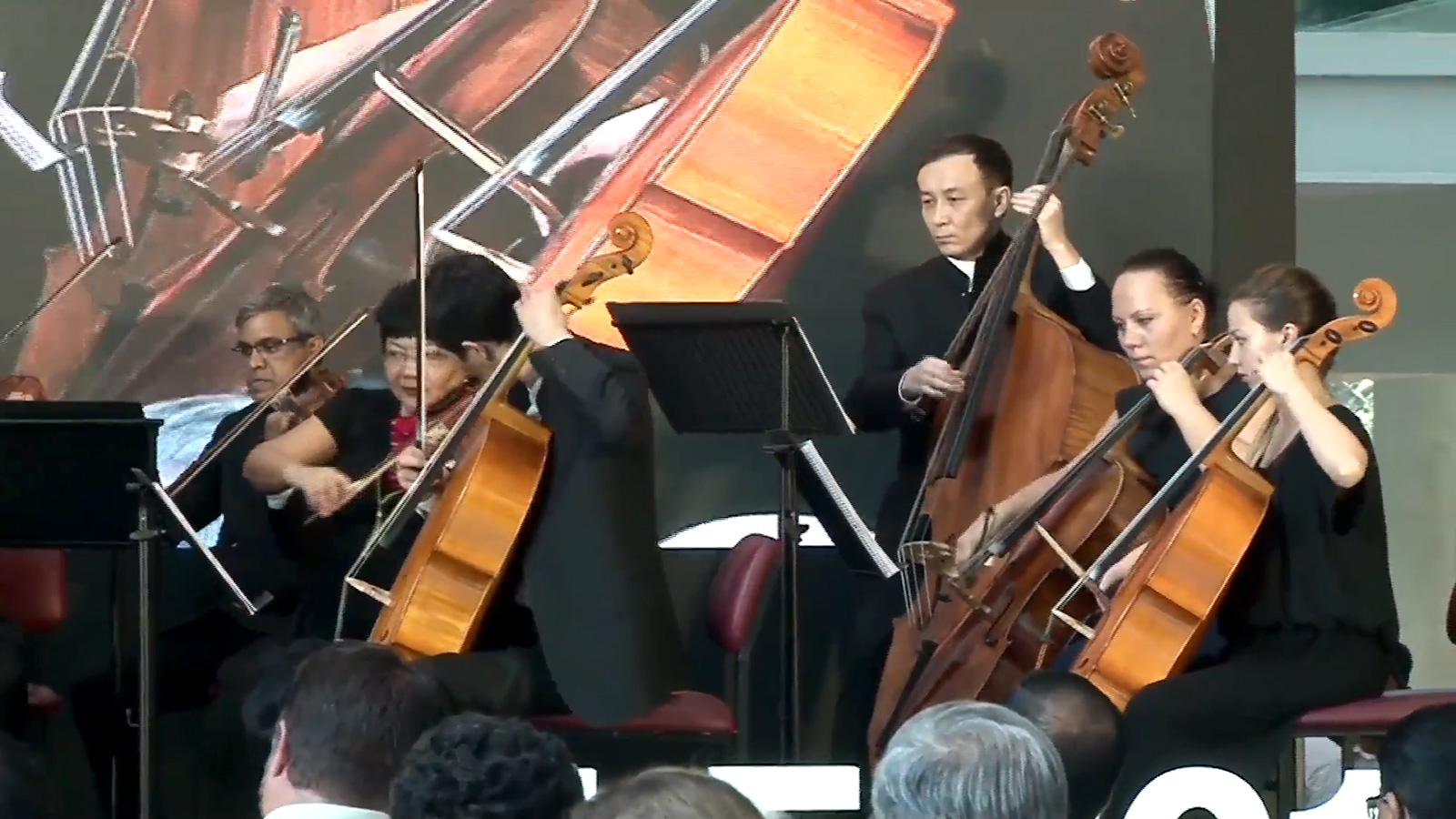A couple of weeks ago, the Godrej Leadership Forum (which consists of the senior leaders in the group) explored the theme of symphony in our work, in our relationships and in our personal lives. Parmesh Shahani, who leads the Godrej India Culture Lab, curated some great sessions with a diverse set of speakers. As part of this meet, we had the privilege of hosting the Symphony Orchestra of India. Here is a link to their amazing performance:
The modern day orchestra as we know it, has evolved over the last 400 years. And what is most remarkable, is that despite all the experimentation, in the last couple of centuries, it hasn’t really seen much change in its core form. It is timeless and still relevant even today, simply because the idea that it is based on is so powerful – bringing together so many individual greats to create music.
And so, drawing from that, my message this week is on what we could learn from an orchestra on creating symphony in our teams and in our lives.
Life is akin to a symphony orchestra
The idea is not a new one – likening our demanding, multifaceted lives to a symphony orchestra, arguably the most complex creation in classical music – and much has been written about it. The parallel isn’t difficult to relate to either, even if you are unfamiliar with the intricacies of an orchestra. As author and ‘virtual guide’ Mike Hyatt explains it in his article Do you practice the 5 habits of a balanced life?: “Like an orchestra, our lives are divided into different parts or areas, each with their own focus. Where an orchestra has strings, brass, woodwinds, and percussion, our lives have work, family, faith, fitness, and so on.” We need all these different parts to come together to create ‘harmony’ – to make us happy – in much the same way that the different players and their instruments each have a role in a symphony.
In fact, this belief that you need all of these different parts, as disparate as they may seem, to come together and make something special, is exactly what our people philosophy of ‘Whole Self’ is based on. We truly believe that unless you are able to live a whole, rounded life and bring all of yourself – the many different hats that you wear – to Godrej, you just won’t be able to be your best at work. In a similar vein, as you think about your teams, you need to bring together individuals with diverse skills and mesh in both left-brained and right-brained approaches to deliver superior performance.
What you could learn from a symphony orchestra
Hyatt lays some great learnings from watching an orchestra. Some of them may sound quite simple and even rather obvious, but the questions they push you to ask yourself are much tougher: What is it that makes you happy? Where does your harmony come from? What kind of balance do you want? What tradeoffs are you comfortable with?
1. Diversity
The magic of a symphony orchestra is its harmony in diversity. A full sized orchestra – it could have between 80-100 musicians in it. But only when each instrument plays, does the magic happen. It’s much the same with our teams and our lives. So, embrace how complex and multilayered it is. Don’t run away from or try to ignore the fact that there are so many different facets to deal with. And don’t be intimidated by it either. You can’t be a business leader stretching for a deadline, without also acknowledging that you are a mother who needs to help her child with school assignments. They all, in their own way, make you who you are. You must learn to thrive in it.
2. Space
Everything has a place. And there is space enough for everything. “The first violin doesn’t try stealing the parts of the woodwinds or the brass.” You can’t do only one thing and expect for the orchestra to perform. You have to make space for the rest. So, if that means that you need to switch off from emails at the dinner table or while reading to your children, make time for the morning run that you have been avoiding, or finally get down to that assignment you have been procrastinating on – do it. You can’t drive only one aspect of your life and expect the rest to fall into place on their own. Similarly, with your team members, you have to make sure that you give them the space to nurture their full potential.
3. Pace
You have to find a pace that works for you. A pace which the different aspects of your life can keep up with. You can’t have your career and your commitments on the home front run at completely different speeds. They have to pace and complement each other, or you will end up torn between them. Finding a balance involves making choices and tradeoffs. These are questions that you will need to answer for yourself.
4. Common purpose
At the heart of it all, everything that you do needs to share a purpose. It is the reason why the orchestra has so many different parts that don’t compete with each other; why they are constantly searching for harmony – because they believe that the symphony is their larger, common purpose. So, in the same way, you can’t have the different aspects of your team or life exist so independent of each other that they don’t share any common purpose. Ask yourself – what is the purpose? All the choices that you make will go back to this.
5. A plan
Like with any other planning that you do, your life and your team too needs a plan. The orchestra works the way it does because it is part of a much larger plan; one that allows its diverse elements to come together and make music. What is your larger plan?
So, even as you think through your life as an orchestra, consider how each of these aspects – diversity, space, pace, purpose and plan – resonate very strongly with our role as leaders. We have always maintained that our biggest strength at Godrej is being able to build on the incredible diversity of our teams. That by digging into and creating our ‘whole brained’ selves, we get our best ideas and are able to innovate and delight our people and consumers.
This ability to appreciate diversity, make space for different ideas and all the while, be rooted in our values and shared vision of becoming an FMCG leader, is our secret sauce. And to get it right, to make the symphony happen, we need to be great conductors.
The reason why the symphony is considered such a complex accomplishment, is because it involves bringing together such a large number of incredibly talented people and then getting them to synchronise their individual performances. So, great conductors are also inevitably great leaders.
Hyatt’s article, 8 leadership lessons from a symphony conductor, lays out some starting points for you to consider:
1. Conductors starts with a plan
Conductors plan. They offer direction. They have a clear idea of what they want their music to sound like, before they start creating it.
2. Great conductors recruit the best players
Your music will only be as good as your players. Great conductors will look to attract great players. And great players will flock to great conductors. It is as simple as that.
3. A conductor is always visible, so everyone can see him
A conductor leads from right up front, so that every member can watch and follow. That’s the crux of the orchestra.
4. Conductors lead with their hearts
Sure, this is about talent, but it is also, as much about heart. A conductor needs to be that deeply passionate about music and his players to be able to drive them to outperform.
5. A conductor delegates and focuses on what only he can do
No conductor tries to do it all, like selling tickets for the show and checking that the orchestra is in tune. Nor can he be playing an instrument. That is delegated to other people. All he does is focus on his role to lead and direct on stage.
6. Conductors are aware of their gestures and their impact
Every slight move that a conductor makes is being followed. All of it has meaning. It impacts the way the symphony gets played out. So, they watch what they say and do on stage very carefully.
7. A conductor keeps his back to the audience
I find this particularly interesting. The conductor is solely focused on his players the entire time, even as the audience watches. The only time he acknowledges them is at the end, after the performance has been delivered.
8. Conductors share the spotlight
At the end of the performance, a conductor will ask his players to bow with him. He openly acknowledges their contribution and has them share in the credit.
In fact, there are plenty of lessons we can learn from the various elements that make a successful symphony orchestra – the melding of rhythm and melody, collaboration, discipline, respect, innovation and team work. As you reflect on your personal lives and how to become more effective in leading your teams, do think about how you can apply some of these principles to create your own symphony.
I look forward to hearing your thoughts.









Dear Vivek,
This is a wonderful way to look at work and life as a whole. Thank you for sharing.
Regards,
Khushboo